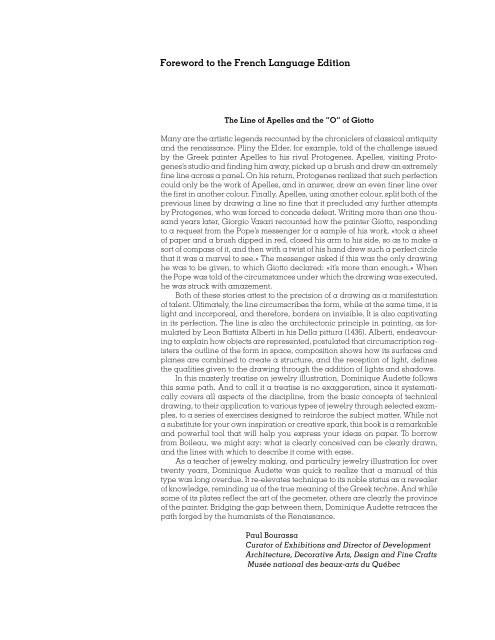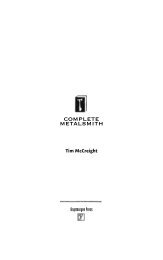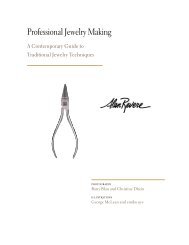Jewelry Illustration - Brynmorgen Press
Jewelry Illustration - Brynmorgen Press
Jewelry Illustration - Brynmorgen Press
Create successful ePaper yourself
Turn your PDF publications into a flip-book with our unique Google optimized e-Paper software.
Foreword to the French Language Edition<br />
The Line of Apelles and the “O” of Giotto<br />
Many are the artistic legends recounted by the chroniclers of classical antiquity<br />
and the renaissance. Pliny the Elder, for example, told of the challenge issued<br />
by the Greek painter Apelles to his rival Protogenes. Apelles, visiting Protogenes’s<br />
studio and finding him away, picked up a brush and drew an extremely<br />
fine line across a panel. On his return, Protogenes realized that such perfection<br />
could only be the work of Apelles, and in answer, drew an even finer line over<br />
the first in another colour. Finally, Apelles, using another colour, split both of the<br />
previous lines by drawing a line so fine that it precluded any further attempts<br />
by Protogenes, who was forced to concede defeat. Writing more than one thousand<br />
years later, Giorgio Vasari recounted how the painter Giotto, responding<br />
to a request from the Pope’s messenger for a sample of his work, «took a sheet<br />
of paper and a brush dipped in red, closed his arm to his side, so as to make a<br />
sort of compass of it, and then with a twist of his hand drew such a perfect circle<br />
that it was a marvel to see.» The messenger asked if this was the only drawing<br />
he was to be given, to which Giotto declared: «it’s more than enough.» When<br />
the Pope was told of the circumstances under which the drawing was executed,<br />
he was struck with amazement.<br />
Both of these stories attest to the precision of a drawing as a manifestation<br />
of talent. Ultimately, the line circumscribes the form, while at the same time, it is<br />
light and incorporeal, and therefore, borders on invisible. It is also captivating<br />
in its perfection. The line is also the architectonic principle in painting, as formulated<br />
by Leon Battista Alberti in his Della pittura (1436). Alberti, endeavouring<br />
to explain how objects are represented, postulated that circumscription registers<br />
the outline of the form in space, composition shows how its surfaces and<br />
planes are combined to create a structure, and the reception of light, defines<br />
the qualities given to the drawing through the addition of lights and shadows.<br />
In this masterly treatise on jewelry illustration, Dominique Audette follows<br />
this same path. And to call it a treatise is no exaggeration, since it systematically<br />
covers all aspects of the discipline, from the basic concepts of technical<br />
drawing, to their application to various types of jewelry through selected examples,<br />
to a series of exercises designed to reinforce the subject matter. While not<br />
a substitute for your own inspiration or creative spark, this book is a remarkable<br />
and powerful tool that will help you express your ideas on paper. To borrow<br />
from Boileau, we might say: what is clearly conceived can be clearly drawn,<br />
and the lines with which to describe it come with ease.<br />
As a teacher of jewelry making, and particulry jewelry illustration for over<br />
twenty years, Dominique Audette was quick to realize that a manual of this<br />
type was long overdue. It re-elevates technique to its noble status as a revealer<br />
of knowledge, reminding us of the true meaning of the Greek techne. And while<br />
some of its plates reflect the art of the geometer, others are clearly the province<br />
of the painter. Bridging the gap between them, Dominique Audette retraces the<br />
path forged by the humanists of the Renaissance.<br />
Paul Bourassa<br />
Curator of Exhibitions and Director of Development<br />
Architecture, Decorative Arts, Design and Fine Crafts<br />
Musée national des beaux-arts du Québec




